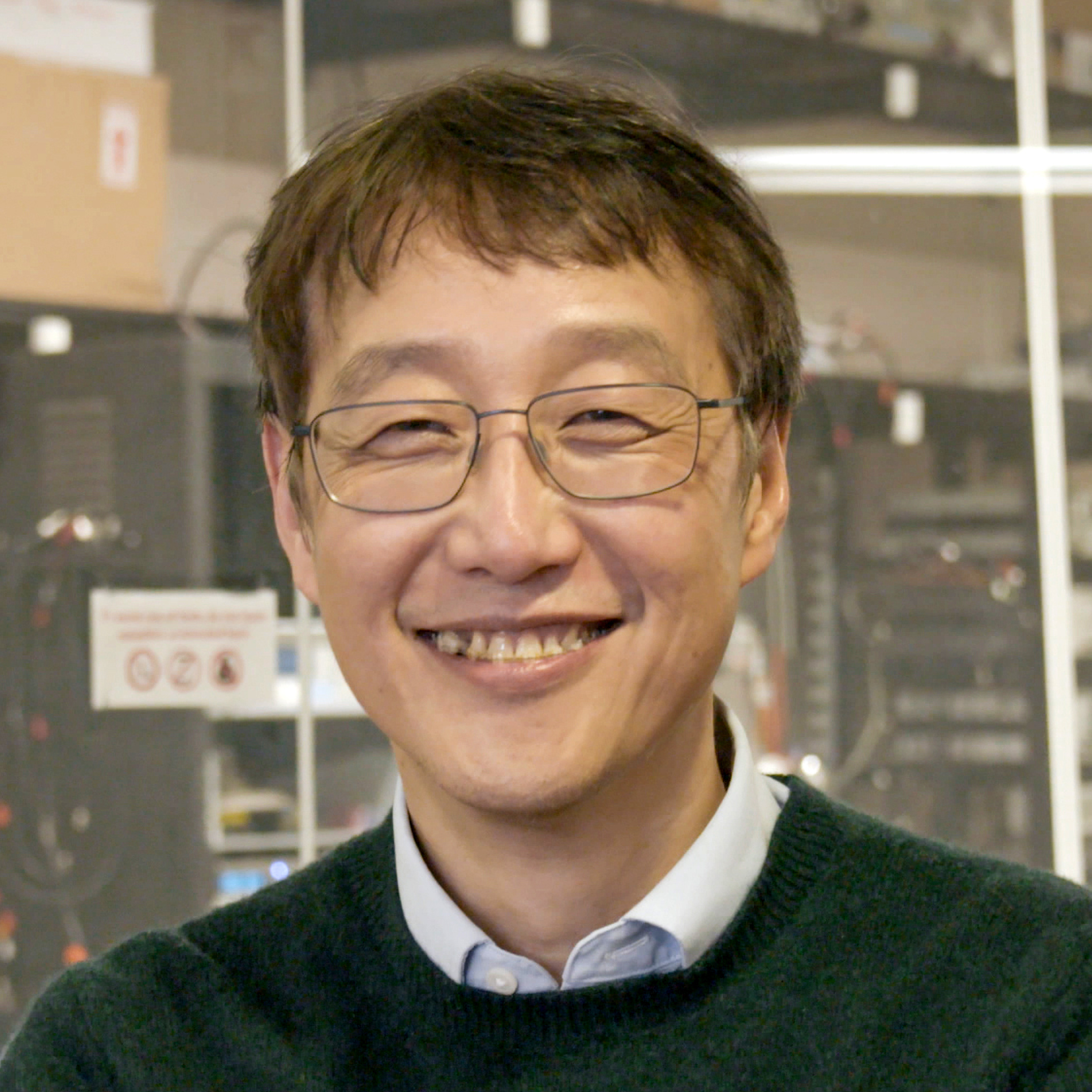
Harvard University | Cambridge, Massachusetts
For pioneering discoveries in the new science of materials composed of single-atom-thick layers, opening the door to a vast array of new technologies.
We experience our everyday world as three-dimensional, and we move through our lives according to that perception. But the universe is more complex, containing more dimensions or sometimes even fewer dimensions than our human senses can readily discern. Some of those lower dimensions are constructs of mathematical theory, but others are quite real in the physical world, some with profound implications and practicality. Though it's so thin that our eyes can barely tell, the two-dimensional form of carbon called graphene is one example, displaying unique properties that promise exciting new applications and technologies. Philip Kim is a leader in the exploration of this new nanoscopic world of what are known as low-dimensional materials. Low-dimensional materials can be as thin as a single atom—the thinnest material possible—which makes the fabrication of ultrasmall novel devices built out of these individual monolayers possible.
Although it was long theorized by some physicists, the idea of graphene, a sheet of carbon atoms arranged in a hexagonal lattice, seemed pretty outlandish to many scientists. Even if such a material were possible, how could one actually isolate it, much less study it or use it for practical purposes? Would there be new physics one can find? While a professor at Columbia in 2002, and already established as a noted researcher of carbon nanostructures, Kim turned to the study of graphene and developed a means of isolating it using atomic force microscopy (AFM) techniques, greatly facilitating the study of its unusual characteristics. In 2004 two scientists from Manchester University, Andre Geim and Kostya Novoselov, demonstrated the existence of graphene. Kim set upon intensive studies on the remarkable electronic, optical, magnetic, and mechanical properties of this thinnest material in universe. Most notably, Kim’s investigations of graphene under strong magnetic fields led to his co-discovery of quantum effects in the material that provided definitive evidence of massless fermions (such as electrons) for the first time. Graphene has also proven to be an important material for the study of various quantum physics phenomena that may make possible the creation of practical quantum electronic devices. Among other unusual attributes, graphene has been shown to display extremely high electrical conductivity and tensile strength, making it an attractive material for use in various devices including semiconductors, batteries, sensors, solar cells, and other electronics. Its light weight coupled with great strength also makes it an obvious candidate for mechanical applications. Kim helped develop new techniques for making and using graphene in large, very high-quality sheets, which is a key factor for multiple applications in electronics, material science, chemistry, sensor technology, and alternative energy systems.
Kim is also known for his significant work in layered microstructures, also known as van der Waals heterostructures, in which single-atom layers of different materials are placed atop one another with only very weak bonds between the planes. This creates unique electronic properties and allows layers of graphene and other substances, such as hexagonal boron nitride, to be built into electronic components such as transistors or memory devices at the nanoscale for practical nanoelectronic and quantum technologies. These new heterostructure properties can result in highly versatile electronic and magnetic phenomena, and future practical devices. Other large contributions at the smallest scale of matter include Kim’s work on carbon nanotubes, graphene sheets rolled into tubular form with diameters only few atoms wide. He showed exquisite electrical and heat flow through this one-dimensional form of carbon nanostrucutres as well as their application for the world’s smallest tweezers, called nanotweezers.
Born in Seoul, South Korea, Kim earned his bachelor's and master's degrees in physics at Seoul National University (SNU) and his Ph.D. in applied physics at Harvard University in 1999. After a postdoctoral fellowship at the University of California, Berkeley, he moved on to Columbia University in 2002, where he began to concentrate intensively on his signature research on low-dimensional structures, particularly graphene. Since 2014 he has been a professor of physics and applied physics at Harvard.
Kim's many achievements in the experimental realm are a testament to the joy he finds in the scientific process. He leads a very large research group, which often implies little time left over for work in the lab, but he is happiest in the lab and is very much a hands-on scientist. He has maintained close ties with Korea and acts as a mentor for students at SNU. While many of his colleagues study the universe at its largest scales, those of stars and galaxies, Kim concentrates on the opposite layers, the universe at its smallest dimensions. For him, they're all connected, and scientific curiosity isn't limited to any particular size or dimension. He has passed on these attitudes to the many students he has mentored. He has been honored with several prestigious awards, including the American Physical Society’s Buckley Prize, the Korean Ho-Am Prize, and the Tomassoni-Chisesi Prize from the Sapienza University of Rome. His work has been revered by other researchers, perhaps best illustrated in Andre Geim's acknowledgement of him during his 2010 Nobel Prize for Physics lecture, during which remarked that he would have been happy to share the Nobel with Kim.
Philip Kim may be a scientist who specializes in the study of low-dimensional materials, but he's anything but one-dimensional himself, by any definition. He is instead a remarkably creative and groundbreaking researcher working at the cutting edge of physics and the frontiers of new technologies that will ultimately benefit us all.
Information as of March 2023

